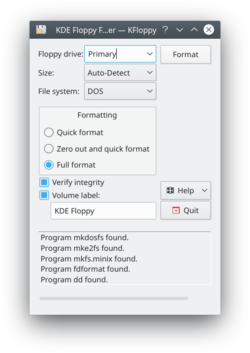KFloppy/pt-br: Difference between revisions
Appearance
Created page with ''''Interface gráfica para formatar disquetes'''' |
Updating to match new version of source page |
||
| (11 intermediate revisions by 3 users not shown) | |||
| Line 1: | Line 1: | ||
<languages /> | <languages /> | ||
A Graphical Tool for formatting floppy disks | |||
[[Image:Kfloppy2.png|thumb|250px|center]] | |||
==Funcionalidades== | |||
* Formatações rápida e completa | |||
* Verificação de setores com defeito (através da verificação de integridade) | |||
* Pode nomear um disco | |||
* Suporta opções pela linha de comando | |||
* Suporta os sistemas de arquivos DOS, ext2, UFS e Minix | |||
{{Note/pt-br|Um disquete não pode ser formatado se estiver montado.}} | |||
* Select the floppy drive which contains the media to be formatted | |||
* Select the size of the floppy to be used. In most cases it is safe to leave this as "Auto-Detect", and should be changed only when encountering size related issues during formatting | |||
* Select a filesystem to be used | |||
** If the desired filesystem is not listed, check the box at the bottom of the window, it may provide a reason | |||
** Not all supported filesystems are usable on floppy disks | |||
* Select the type of format to perform | |||
** Quick Format is as the name implies, the fastest process. It does check for bad blocks or other errors | |||
** Zero out and quick format will overwrite each sector with zeroes. This should not be relied on for securely erasing a disk, only a quick method of destroying data | |||
** Full format will format the media, and check for bad blocks and other filesystem defects if possible | |||
* Check '''Verify Integrity''' if KFloppy is to check if the format was successful | |||
* Provide a name for the floppy, if desired | |||
* Click '''Format''' to format the media | |||
==More Information== | |||
Read about the full capabilities in [http://docs.kde.org/development/en/kdeutils/kfloppy/index.html the application's Handbook] | Read about the full capabilities in [http://docs.kde.org/development/en/kdeutils/kfloppy/index.html the application's Handbook] | ||
[[Category: | [[Category:Utilitários/pt-br]] | ||
[[Category: | [[Category:Gerenciamento de Arquivos/pt-br]] | ||
Latest revision as of 06:50, 26 December 2018
A Graphical Tool for formatting floppy disks

Funcionalidades
- Formatações rápida e completa
- Verificação de setores com defeito (através da verificação de integridade)
- Pode nomear um disco
- Suporta opções pela linha de comando
- Suporta os sistemas de arquivos DOS, ext2, UFS e Minix
- Select the floppy drive which contains the media to be formatted
- Select the size of the floppy to be used. In most cases it is safe to leave this as "Auto-Detect", and should be changed only when encountering size related issues during formatting
- Select a filesystem to be used
- If the desired filesystem is not listed, check the box at the bottom of the window, it may provide a reason
- Not all supported filesystems are usable on floppy disks
- Select the type of format to perform
- Quick Format is as the name implies, the fastest process. It does check for bad blocks or other errors
- Zero out and quick format will overwrite each sector with zeroes. This should not be relied on for securely erasing a disk, only a quick method of destroying data
- Full format will format the media, and check for bad blocks and other filesystem defects if possible
- Check Verify Integrity if KFloppy is to check if the format was successful
- Provide a name for the floppy, if desired
- Click Format to format the media
More Information
Read about the full capabilities in the application's Handbook

